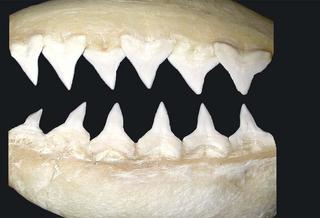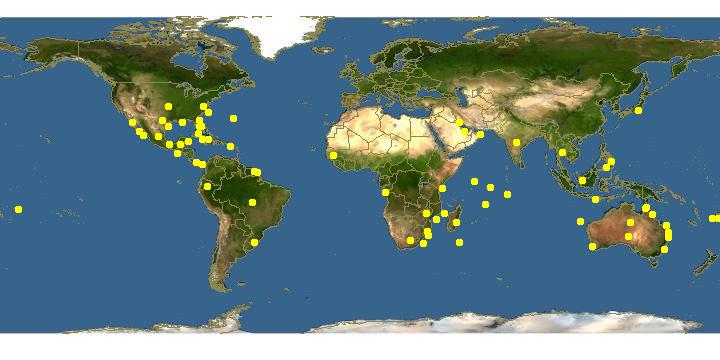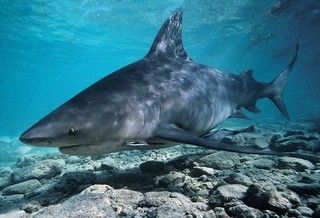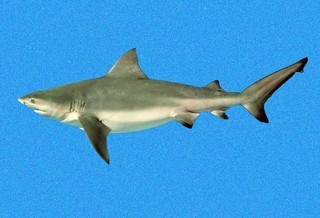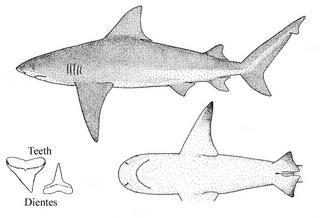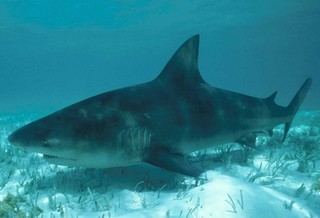|
| Links |
We parsed the following live from the Web into this page. Such content is managed by its original site and not cached on Discover Life. Please send feedback and corrections directly to the source. See original regarding copyrights and terms of use.
- Australian Faunal Directory
- FishBase
|
|
español |
|
|
Overview |
Main identification features
- heavy body;snout very short, round
- 1st dorsal fin broad, high, pointed, origin over pectoral insertion
- pectoral: broad, pointed
Heavy-bodied; snout short and broadly rounded; eye small; no ridge on back between dorsal fins; origin of first dorsal fin usually over or just posterior to pectoral axil; first dorsal fin moderately large, its height 7.0-11.3% of total length; apex of first dorsal fairly pointed; origin of second dorsal distinctly in front of anal origin; pectoral wide, pointed.
Grey, becoming white ventrally, often with faint pale grey horizontal band extending into the white of the upper abdomen; fins of small individuals with dusky tips or edges, adults plain.
May reach 350 cm; size at birth 56-81cm.
Habitat: continental coasts, estuarine, muddy areas, lagoons, often travels far up rivers.
Depth: 0-150 m.
All tropical and subtropical seas; southern California to the Gulf and to Peru, Malpelo and the Revillagigedos.
Attributes
Abundance: Common.
Cites: Not listed.
Climate Zone: North Temperate (Californian Province &/or Northern Gulf of California); Northern Subtropical (Cortez Province + Sinaloan Gap); Northern Tropical (Mexican Province to Nicaragua + Revillagigedos); Equatorial (Costa Rica to Ecuador + Galapagos, Clipperton, Cocos, Malpelo); South Temperate (Peruvian Province ).
Depth Range Max: 150 m.
Depth Range Min: 0 m.
Diet: bony fishes; mobile benthic crustacea (shrimps/crabs); octopus/squid/cuttlefish; sharks/rays; sea snakes/mammals/turtles/birds; mobile benthic gastropods/bivalves.
Eastern Pacific Range: Northern limit=33; Southern limit=-9; Western limit=-118; Eastern limit=-78; Latitudinal range=42; Longitudinal range=40.
Egg Type: Live birth; No pelagic larva.
Feeding Group: Carnivore.
FishBase Habitat: Demersal.
Global Endemism: Circumtropical ( Indian + Pacific + Atlantic Oceans); East Pacific + Atlantic (East +/or West); Transisthmian (East Pacific + Atlantic of Central America); East Pacific + all Atlantic (East+West); All Pacific (West + Central + East); TEP non-endemic; "Transpacific" (East + Central &/or West Pacific); All species.
Habitat: Corals; Reef associated (reef + edges-water column & soft bottom); Mangrove; Water column; Reef (rock &/or coral); Rocks; Reef and soft bottom; Soft bottom (mud, sand,gravel, beach, estuary & mangrove); Mud; Sand & gravel; Beach; Estuary; Freshwater.
Inshore Offshore: Inshore; Inshore Only.
IUCN Red List: Near threatened; Listed.
Length Max: 350 cm.
Regional Endemism: Island (s); Continent; Continent + Island (s); Eastern Pacific non-endemic; Tropical Eastern Pacific (TEP) non-endemic; All species.
Residency: Resident.
Salinity: Brackish; Freshwater; Marine.
Water Column Position: Mid Water; Near Bottom; Near Surface; Surface; Bottom + water column;
|
|
|
Names | |
|
|
|
Links to other sites | |
|
|
|
References |
- Bellido-Millán, J.M. and Villavicencio-Garayzar, C.J., 2002., Pesqueria artesanal de tiburon en la region central del Golfo de California. En: Lozano-Vilano, M. L. (Ed.). Libro Jubilar en Honor al Dr. Salvador Contreras Balderas., Universidad Autonoma de Nuevo León:143-152.
- Béarez, P., 1996., Lista de los Peces Marinos del Ecuador Continental., Revista de Biologia Tropical, 44:731-741.
- Candanedo , C. and D'Croz, L., 1983., Ecosistema acuático del lago Bayano: un embalse tropical., Publicación Técnica IRHE, Dirección de Ingenieria, Departamento de Hidrometeorología, Panamá., :38pp.
- Castri-Aguirre, J.L., Espinoza-Pérez, H. and Schmitter-Soto, J.J., 2002., Lista sitemática, biogeográfica y ecológica de la ictiofauna estuarino lagunar y vicaria de México. En: Lozano-Vilano, M. L. (Ed.). Libro Jubilar en Honor al Dr. Salvador Contreras Balderas., Universidad Autonoma de Nuevo León:117-142.
- Castro-Aguirre, J.L. and Balart, E.F., 2002., La ictiofauna de las islas Revillagigedos y sus relaciones zoogeograficas, con comentarios acerca de su origen y evolucion. En: Lozano-Vilano, M. L. (Ed.). Libro Jubilar en Honor al Dr. Salvador Contreras Balderas., Universidad Autonoma de Nuevo León:153-170.
- Castro-Aguirre, J.L., 1999., Ictiofauna estuarino-lagunar y vicaria de México., Editorial Limusa S.A. de C.V.: 1-629pp.
- Compagno , L. J. V. and Cook, S. F., 1995., The exploitation and conservation of freshwater elasmobranchs: status of taxa and prospects for the future., Journal of Aquariculture and Aquatic Sciences, 7:62-90.
- Compagno, L.J.V., 1999., Checklist of living elasmobranchs. In Hamlett W.C. (ed.) Sharks, skates, and rays: the biology of elasmobranch fishes., The John Hopkins University Press:471-498.
- Compagno, L.J.V., 1984., Sharks of the World. An annotated and illustrated catalogue of shark species known to date. Part 2. Carcharhiniformes. FAO Species Catalogue., FAO Fish. Synop. No 125, 4(2):251-655.
- Eschmeyer , W. N. , Herald , E. S. and Hamman, H., 1983., A field guide to Pacific coast fishes of North America from the Gulf of Alaska to Baja California. Peterson Field Guide Ser. 28., Houghton Mifflin:336pp.
- Findley, L.T., Hendrickx, M.E., Brusca, R.C., van der Heiden, A.M., Hastings, P.A., Torre, J., 2003., Diversidad de la Macrofauna Marina del Golfo de California, Mexico., CD-ROM versión 1.0. Projecto de la Macrofauna del Golfo . Derechos reservados de los autores y Conservación Internacional.
- Fischer , W. , Krup , F. , Schneider , W. , Sommer , C. , Carpenter , K. E. and Niem, V. H., 1995., Guia FAO para la Identificacion de Especies de para los fines de la Pesca. Pacifico Centro-Oriental. Volumen II. Vertebrados - Parte 1., FAO2:647-1200.
- Galván-Magaña, F., Abitia-Cárdenas, L.A., Rodríguez-Romero, J., Pérez-España, H., Chávez-Ramos, H., 1996., Systematics list of the fishes from Cerralvo island, Baja California Sur, Mexico., Ciencias Marinas, 22:295-311.
- Galván-Magaña, F., Gutiérrez-Sánchez, F., Abitia-Cárdenas, L.A., Rodríguez-Romero, J., 2000., The distribution and affinities of the shore fishes of the Baja California Sur lagoons. In Aquatic Ecosystems of Mexico: Status and Scope. Eds. M. Manuwar, S.G. Lawrence, I.F. Manuwar & D.F. Malley. Ecovision World Monograph Series., Backhuys Publishers:383-398.
- Jimenez-Prado, P., Béarez, P., 2004., Peces marinos del Ecuador continental / Marine fishes of continental Ecuador., SIMBIOE/NAZCA/IFEA tomo 1 y 2.
- Lopez , M. I. and Bussing, W. A., 1982., Lista provisional de los peces marinos de la Costa Rica., Revista de Biologia Tropical, 30(1):5-26.
- Love, M.S., Mecklenburg, C.W., Mecklenburg, T.A., Thorsteinson, L.K., 2005., es of the West Coast and Alaska: a checklist of North Pacific and Artic Ocena species from Baja California to the Alaska-Yukon border., U.S. Department of the Interior, U.S. Geological Survey, Biological Resources Division, 288pp.
- Madrid Vera , J. , Ruíz Luna , A. and Rosado Bravo, I., 1998., Peces de la plataforma continental de Michoacán y sus relaciones regionales en el Pacífico mexicano., Revista de Biologia Tropical, 42(2):267-276.
- McCosker , J.E. and Rosenblatt, R.H., 1975., Fishes collected at Malpelo Island. In Graham, J.B. (ed.) The Biological Investigation of Malpelo Island, Colombia., Smithsonian Contrib. Zool., 176:91-93.
- Müller , J. and Henle, F. G. J., 1839., Systematische Beschreibung der Plagiostomen. Berlin., Plagiostomen, :27-102.
- Ramírez Rodríguez, M., 1997., Producción pesquera en la Bahía de La Paz, B.C.S.. En Urbán Ramírez, J. y M. Ramírez Rodríguez (Eds.). La Bahía de La Paz investigación y conservación., Universidad Autónoma de Baja California Sur:273-282.
- Rubio, E.A., 1986., Notas sobre la ictiofauna de la Isla de Gorgona, Colombia., Boletin Ecotropica. Univ. Bog. Jorge Tadeo Lozano, 13:86-112.
- Rubio, E.A., 1988., Estudio taxonomico de la ictiofauna acompañante del camaron en areas costeras del Pacifico de Colombia., Memorias del VI Seminario Nacional de las Ciencias del Mar. Comisión Colombiana de Oceanografía. Bogota, Colombia., :169-183.
- Starks, E. C., 1906., On a Collection of fishes made by P. O. Simons in Ecuador and Peru., Proc. U.S. Nat. Mus., 30:761-800.
- Van der Heiden , A. M. and Findley, L. T., 1988., Lista de los peces marinos del sur de Sinaloa, México., Anales del Centro de Ciencias del Mar y Limnologia de la Universidad Autonoma Nacional de Mexico, 15:209-224.
- Vega, A.J., Villareal, N., 2003., Peces asociados a arrecifes y manglares en el Parque Nacional Coiba., Tecnociencia, 5:65-76.
|
|
|
Acknowledgements | |
I thank Ashley MacDonald and John Pickering, University of Georgia, for technical support in building this page.
|
|
| Supported by | |
|
Following modified from Australian Faunal Directory
|
Top | See original
| &pull 20q v5.145 20180528: Error 301 Moved Permanently http://biodiversity.org.au/afd/taxa/33780c17-6ce3-4315-8ccf-850a40ed0be6 |
|
Following modified from FishBase
|
Top | See original
http://www.fishbase.org/Summary/speciesSummary.php?genusname=Carcharhinus&speciesname=leucas ---> http://52.67.158.155/Summary/speciesSummary.php?genusname=Carcharhinus&speciesname=leucas
http://52.67.158.155/Summary/speciesSummary.php?genusname=Carcharhinus&speciesname=leucas ---> https://fishbase.net.br/Summary/speciesSummary.php?genusname=Carcharhinus&speciesname=leucas
&pull 20q v5.145 20180528: Error 501 Protocol scheme 'https' is not supported (LWP::Protocol::https not installed) https://fishbase.net.br/Summary/speciesSummary.php?genusname=Carcharhinus&speciesname=leucas |
Updated: 2024-04-26 11:00:31 gmt
|
